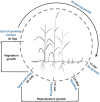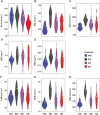Changes in mass allocation play a more prominent role than morphology in resource acquisition of the rhizomatous Leymus chinensis under drought stress
- PMID: 37279964
- PMCID: PMC10550271
- DOI: 10.1093/aob/mcad073
Changes in mass allocation play a more prominent role than morphology in resource acquisition of the rhizomatous Leymus chinensis under drought stress
Abstract
Background and aims: Plants can respond to drought by changing their relative investments in the biomass and morphology of each organ. The aims of this study were to quantify the relative contribution of changes in morphology vs. allocation and determine how they affect each other. These results should help us understand the mechanisms that plants use to respond to drought events.
Methods: In a glasshouse experiment, we applied a drought treatment (well-watered vs. drought) at early and late stages of plant growth, leading to four treatment combinations (well-watered in both early and late periods, WW; drought in the early period and well-watered in the late period, DW; well-watered in the early period and drought in the late period, WD; drought in both early and late periods, DD). We used the variance partitioning method to compare the contribution of organ (leaf and root) biomass allocation and morphology to the leaf area ratio, root length ratio and root area ratio, for the rhizomatous grass Leymus chinensis (Trin.) Tzvelev.
Key results: Compared with the continuously well-watered treatment, the leaf area ratio, root length ratio and root area ratio showed increasing trends under various drought treatments. The contribution of leaf mass allocation to leaf area ratio differed among the drought treatments and was 2.1- to 5.3-fold greater than leaf morphology, and the contribution of root mass allocation to root length ratio was ~2-fold greater than that of root morphology. In contrast, root morphology contributed more to the root area ratio than biomass allocation under drought in both the early and late periods. There was a negative correlation between the ratio of leaf mass fraction to root mass fraction and the ratio of specific leaf area to specific root length (or specific root area).
Conclusions: This study suggested that organ biomass allocation drove a larger proportion of variation than morphological traits for the absorption of resources in this rhizomatous grass. These findings should help us understand the adaptive mechanisms of plants when they are confronted with drought stress.
Keywords: Rhizomatous grass; biomass allocation; drought stress; drought timing; plant functional trait.
© Crown copyright 2023.
Figures





Similar articles
-
Fast plants have water-use and drought strategies that balance rainfall retention and drought survival on green roofs.Ecol Appl. 2022 Jan;32(1):e02486. doi: 10.1002/eap.2486. Epub 2021 Dec 9. Ecol Appl. 2022. PMID: 34674341
-
Above- and below-ground plant traits are not consistent in response to drought and competition treatments.Ann Bot. 2022 Dec 31;130(7):939-950. doi: 10.1093/aob/mcac108. Ann Bot. 2022. PMID: 36001733 Free PMC article.
-
Broader leaves result in better performance of indica rice under drought stress.J Plant Physiol. 2010 Sep 1;167(13):1066-75. doi: 10.1016/j.jplph.2010.03.003. Epub 2010 Apr 13. J Plant Physiol. 2010. PMID: 20392520
-
Growth potential limits drought morphological plasticity in seedlings from six Eucalyptus provenances.Tree Physiol. 2016 Feb;36(2):243-51. doi: 10.1093/treephys/tpv137. Epub 2016 Jan 19. Tree Physiol. 2016. PMID: 26786540
-
Genotypic variation in biomass allocation in response to field drought has a greater affect on yield than gas exchange or phenology.BMC Plant Biol. 2016 Aug 24;16(1):185. doi: 10.1186/s12870-016-0876-3. BMC Plant Biol. 2016. PMID: 27558796 Free PMC article.
References
-
- Acuña-Míguez B, Olano JM, Valladares F, García-Hidalgo M, Bravo-Oviedo A.. 2022. Increased recovery in coarse‐root secondary growth improves resilience to drought in transition forests. Journal of Ecology 111: 170–181. doi:10.1111/1365-2745.14024. - DOI
-
- Aerts R, Chapin FS.. 1999. The mineral nutrition of wild plants revisited: a re-evaluation of processes and patterns. Advances in Ecological Research 30: 1–67. doi:10.1016/S0065-2504(08)60016-1. - DOI
-
- Alvarez-Flores R, Winkel T, Nguyen-Thi-Truc A, Joffre R.. 2014. Root foraging capacity depends on root system architecture and ontogeny in seedlings of three Andean Chenopodium species. Plant and Soil 380: 415–428. doi:10.1007/s11104-014-2105-x. - DOI
MeSH terms
Substances
LinkOut - more resources
Full Text Sources

